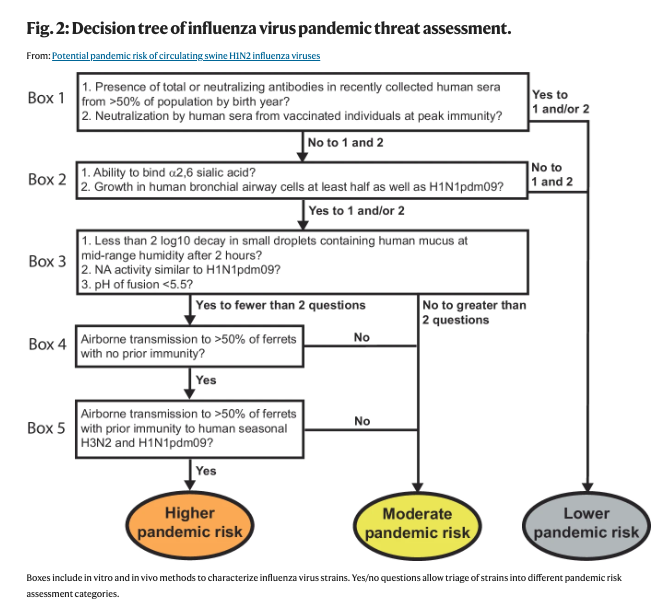Animal influenza viruses such as swine and bird flu pose a risk to humans, in particular those in the farming and veterinarian communities. Most recently, flu viruses have been circulating in cow populations, contaminating machinery and milk, leading to cases of infection amongst farmworkers. While the virus is not yet spreading from person to person, understanding the pandemic potential of these animal flu viruses is critical to control the spread of disease. Now, a new system developed by leading virologists can help identify the pandemic risk of viruses to aid in early intervention.
In a recent study out of Nature Communications, a team of researchers led by Seema Lakdawala, PhD, a virology expert at Emory University School of Medicine, looked at swine flu virus transmission in a ferret model. In this model, ferrets that already had seasonal flu immunity still contracted the virus. The findings indicate that humans, who have had exposure to seasonal flu viruses annually starting from a very young age, are also susceptible to novel viruses. Lakdawala finds this problematic, especially considering the latest avian flu strain, H5N1, circulating throughout dairy cattle herds at a rapid pace.
“Every novel pandemic comes up in the context of pre-existing immunity,” says Lakdawala. “But currently the CDC and WHO do not require assessment of emerging pandemic threats in the context of pre-existing immunity. This is why we created a triage system that incorporates this feature into the risk assessment.”
To complement existing risk assessment tools by CDC and WHO, Lakdawala and team established a triage system that allows researchers to characterize any emerging threat of influenza for its pandemic potential using well-defined characteristics of pandemic viruses. The paper goes on to state that continued surveillance efforts are needed to capture zoonotic events — diseases that jump from animals to humans. Additionally, an increased public health campaign to vaccinate swine, cattle and humans against swine H1N2 virus will curb the spread of disease.
Why it matters
Today, as avian flu H5N1 continues to spread widely in migratory birds, poultry, dairy cattle and cats, there is a need to better define the pandemic risk to humans. Lakdawala and her team are utilizing aspects of the pandemic preparedness triage system tool to assess the risk of current avian and cattle H5N1 viruses.
“We want to have a system as influenza pandemic threats emerge so that we have a way of cataloging and characterizing them,” says Lakdawala. “We expect our tools to help shape the way we characterize emerging pandemic viruses.”
Lakdawala says that the pandemic risk assessment tools can also be applied to how viruses are passed amongst a group of animals, like dairy cattle. Her group published a paper in the Journal of Emerging Infectious Diseases observing that unpasteurized milk stabilizes the virus in the environment such that the H5 virus will remain infectious on milking equipment for hours and may be how the virus is moving from one cow to another on the same farm. The research suggests that personal protective equipment (PPE) such as face shields, masks and eye protection are needed to ensure reduced spillover of H5N1 from dairy cows to humans.
As people attend Four-H festivals in the summer months, there is more of a risk of cow and pig transmission of viruses to children and adults. With these close interactions, Lakdawala notes that everyone in the public health sphere needs to be aware and concerned about respiratory infections. Large animal veterinarians and farm workers also need the appropriate PPE and vaccination opportunities to protect themselves from the viruses.
“Everyone plays a part in pandemic preparedness, not just scientists but the general public as well,” says Lakdawala. “To stay safe this summer, it’s critical to wash hands and reduce contact with livestock and birds if possible. That’s one major step in curbing the spread of H5N1 that everyone can take part in.”
A deeper dive into the triage system

In the Nature Communications study, swine flu H1N2 and H1N1 — from two of the most prevalent lineages of swine viruses across the U.S. which have caused sporadic human infection — were closely examined.
The triage system involved looking at molecular features like stability in the environment, immunity against the virus in human sera by different age cohorts and transmission to immune animals, and the ability for naturally infected ferrets to forward transmit the virus.
Taken together, the data demonstrated that H1N2 virus strain tested poses a higher pandemic risk than H1N1 virus tested. However, the disease in ferrets with prior human seasonal influenza virus immunity is lower, suggesting less severe disease of this virus in the population. The paper goes on to state that continued surveillance efforts are needed to capture zoonotic events. Additionally, an increased campaign is needed to vaccinate swine to reduce the amount of swine H1N2 virus in the U.S.

